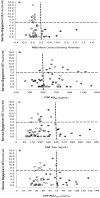Exercise and Alzheimer's disease biomarkers in cognitively normal older adults
- PMID: 20818789
- PMCID: PMC2936720
- DOI: 10.1002/ana.22096
Exercise and Alzheimer's disease biomarkers in cognitively normal older adults
Abstract
Objective: In addition to the increasingly recognized role of physical exercise in maintaining cognition, exercise may influence Alzheimer's disease (AD) pathology, as transgenic mouse studies show lowered levels of AD pathology in exercise groups. The objective of this study was to elucidate the association between exercise and AD pathology in humans using Pittsburgh compound-B (PIB), amyloid-beta (Abeta)(42), tau, and phosphorylated tau (ptau)(181) biomarkers.
Methods: Sixty-nine older adults (17 males, 52 females) aged 55 to 88 years, were recruited and confirmed to be cognitively normal. A questionnaire on physical exercise levels over the past decade was administered to all. Cerebrospinal fluid samples were collected from 56 participants, and amyloid imaging with PIB was performed on 54 participants.
Results: Participants were classified based on biomarker levels. Those with elevated PIB (p = 0.030), tau (p = 0.040), and ptau(181) (p = 0.044) had significantly lower exercise, with a nonsignificant trend for lower Abeta(42) (p = 0.135) to be associated with less exercise. Results were similar for PIB after controlling for covariates; tau (p = 0.115) and ptau(181) (p = 0.123) differences were reduced to nonsignificant trends. Additional analyses also demonstrated that active individuals who met the exercise guidelines set by the American Heart Association had significantly lower PIB binding and higher Abeta(42) levels with and without controlling for covariates (PIB: p = 0.006 and p = 0.001; Abeta(42): p = 0.042 and p = 0.046). Last, the associations between exercise engagement and PIB levels were more prominent in APOE epsilon 4 noncarriers.
Interpretation: Collectively, these results are supportive of an association between exercise engagement and AD biomarkers in cognitively normal older adults.
Figures

Comment in
-
Biomarkers of Alzheimer's disease and exercise: one step closer to prevention.Ann Neurol. 2010 Sep;68(3):275-6. doi: 10.1002/ana.22143. Ann Neurol. 2010. PMID: 20818785 No abstract available.
References
-
- Hulette CM, Welsh-Bohmer KA, Murray MG, et al. Neuropathological and neuropsychological changes in “normal” aging: evidence for preclinical Alzheimer disease in cognitively normal individuals. J Neuropathol Exp Neurol. 1998;57:1168–1174. - PubMed
-
- Morris JC, Price AL. Pathologic correlates of nondemented aging, mild cognitive impairment, and early-stage Alzheimer's disease. J Mol Neurosci. 2001;17:101–118. - PubMed
-
- Hillman CH, Erickson KI, Kramer AF. Be smart, exercise your heart: exercise effects on brain and cognition. Nat Rev Neurosci. 2008;9:58–65. - PubMed
-
- Guideline for Alzheimer's disease management. Chicago, IL: Alzheimer's Association; 2008.
Publication types
MeSH terms
Substances
Grants and funding
LinkOut - more resources
Full Text Sources
Other Literature Sources
Medical
Miscellaneous

